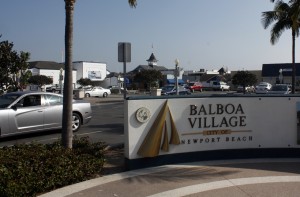
The full moon crested the bay outside the windows of the Balboa Pavilion while a full house of residents convened upstairs in the banquet room on the evening of February 4 to participate in a discussion about the proposed improvements to Balboa Village.
The Balboa Village Advisory Committee (appointed by the Newport Beach City Council) attended the meeting along with Mayor Pro Tem Diane Dixon. The meeting was spearheaded by the Community Development Department’s Director, Kim Brandt, along with Brenda Wisneski, Deputy Director and Jim Campbell, Principal Planner.
As Chair of the Balboa Village Advisory Committee, this was Dixon’s first community event. Pleased with the large turnout by the residents, she remarked that it had been a long time coming and would not have happened without the dedicated staff and involvement of the community.
The Balboa Village Advisory Committee also consists of Councilmember Tony Petros, Gloria Oakes of Balboa Peninsula Point Association, Ralph Rodheim of Balboa Village Merchants Association, Grace Dove of the Central Newport Beach Community Association, Tom Pollack of ExplorOcan, and Jim Stratton, At-Large Representative.
Though several other Village improvements were on the agenda, the most anticipated one involved Parking Management’s proposal that included both Village parking and Residential Permit Parking or RP3.
Of the two, RP3 garnered some feisty yet very valid questions from the audience and a few relevant growls from a resident’s small dog sitting on a chair.
Campbell initially outlined the proposed RP3 program, pointing out it is a two step phase where Phase I involves Island Avenue to Adams; and Phase II from Island Avenue further west to 7th Avenue.
A parking permit would be required but does not guarantee a parking space and would be in effect from 4 p.m. to 9 a.m. daily. Residents would have up to four annual passes at a cost of $16 dollars each, and six guest passes for $1 each. It was noted that without a parking permit, clearly a citation would be administered.
The pros and cons were addressed verbally by Brandt, prompted by questions from the audience.
Pros: Though the program’s permits do not guarantee parking on the street, from 4 p.m. to 9 a.m. the only people allowed to park on the public streets adjacent to the residents’ homes will be ones who reside in the neighborhood.
Employees from the Village or non-local visitors to the area will not be able to park there during the specified hours, leaving the spaces for residents only.
Cons: Residents are not guaranteed a parking place just because a permit is granted, but the likelihood of parking is greatly increased because more parking spaces will be available due to employees and other non-residents no longer parking within the residential neighborhoods.
The program is only in the proposal stages and requires a majority vote from the residents within the program’s boundaries. After Campbell recited the constructs of the program he opened up a question/answer session.
The first question from the residents was to the point, asking Campbell how the committee thinks that the residents in the Village would want RP3. There were loud claps of approval at the remark.
Campbell responded that he failed to mention several residents in this area had identified the problem and worked together with the committee to propose a solution. Now, the committee is asking the majority of residents what they think about it.
Another question brought up was if the RP3 is legal. Campbell responded if the majority of residents approve of this program, then it fits the requirements of the municipal code and is indeed legal. He also stated the money received from this program is not the motivating factor. It will cover the cost to implement RP3 and also go back into the district to use for other improvements to the area. The motivating factor is getting a handle on the parking problem.
A local attorney in the audience noted it is important to understand the exact process this program has followed. Brandt clarified for the residents the city council directed staff members like herself and Campbell to provide an advisory ballet so the residents can choose. Residents obtaining a ballot tonight and mailing it assures them of a vote. Once the committee receives all votes from the residents, including the ones they had to field door-to-door from missing ballots, the results of this survey will be available in the form of a staff report prepared in advance of the city council meeting. Residents will have at least five days to review the written staff report with the committee’s analysis before it goes to the city council.
Other items on the committee’s agenda included Village improvements such as the streetscape with updated benches, the spreading of bike racks, and landscaping that has been reviewed by the city’s park departments.
Wayfinding signage was another significant improvement to point tourists towards available parking areas and help alleviate parking problems which might contribute to keeping potential customers away from businesses.
The Façade Improvement Grant Program was also discussed. The program was developed to provide, on a first-come-first-served basis, a grant program to help business and property owners obtain funding to physically help freshen up their facades such as landscaping, signage, lighting or painting.
Campbell announced that new parking strategies adopted by the city council are due to go into effect on February 12. Basically, off-street parking requirements have been eliminated for businesses.
Campbell also stated the city is going to maintain current parking while improving and expanding on it over time. There will be shared parking, where vacant parking spaces at night can be opened up for other uses. This will hopefully put cars off the street by using the parking made available.
Ten businesses in the district have been paying the city yearly dues, an unfair burden, and the council has suspended those in-lieu parking fees.
Parking fees will be lowered in the winter to include parking meters. This was done purposely so more people can come down to visit the Village. The committee’s thoughts are if fees and parking are a problem, reducing them can help.
Employees will be offered a $50 annual permit. This does not give any priority for parking (during summertime it is expected there will probably never be any parking readily available). There will be parking validation with discount parking rates for businesses and only for Village parking.
The discussion ended with RP3 and all the activity it generated; other project updates, including ExplorOcean and Balboa Theatre, were not discussed.
Dixon greeted residents after the meeting ended and listened attentively to their comments.
Asked if she was expecting such an animated response from the residents about the RP3 program she smiled. “I am delighted to get these opinions from the residents because this is what makes a community stronger.”




